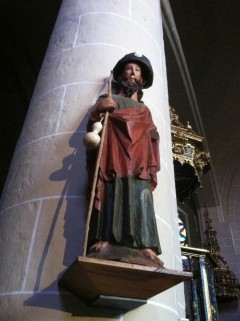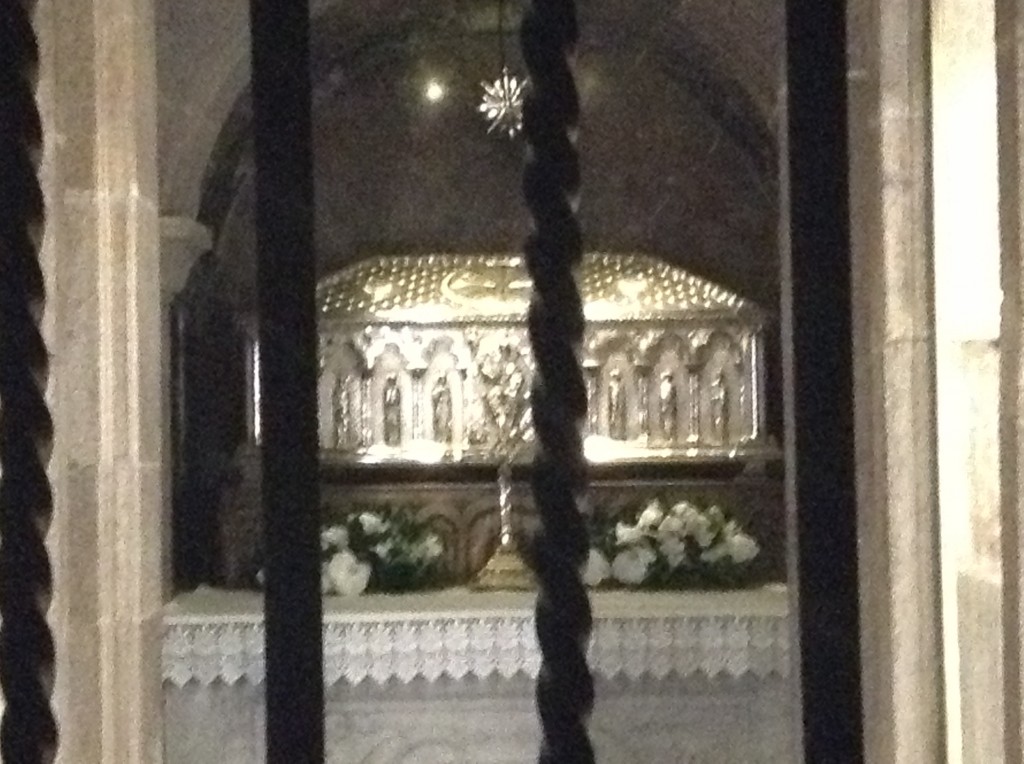Santiago Apóstol, Peregrino, Matamoros
Today is the feast of Saint James the Apostle, son of Zebedee and Salome of Bethsaida, brother of Saint John the Apostle and Evangelist.
One of the “Sons of Thunder” (Mark 3:17).
Santiago.
On this day last year, I wrote about what we know of Saint James from scripture and tradition.
That was before I had walked 500 miles to his sepulcher in Santiago de Compostela.
That was before I knelt before his mortal remains.
Here’s the thing, the tradition has it that while he was in Hispania, the apostle made only a handful of converts. He returned to Jerusalem about a decade after Christ’s Crucifixion, only to himself be martyred on the order of King Herod Agrippa I of Judea (Acts 12).
By any standard James was a failure as a preacher.
But look at what he’s done in the centuries since his death.
According to the Pilgrim’s Office at the Cathedral, in 2012 192,488 pilgrims walked some portion of the Camino.That’s just last year.
How many millions of pilgrims over the centuries have walked the Way?
Make no mistake about it, the Saint is watching over every one of those pilgrims every step of the way.
And while not every pilgrim walks the Way as a Conversatio Morum, in my experience most do in some form or another. The Way of Saint James forces us to “a continual change of heart, a daily reshaping of the mind and heart according to God’s plan for us”.
When faced with some difficulty or need, every Peregrino who I encountered took to heart some form of the phrase “the Camino provides”. This is, of course, only an inch away from Deus providebit – God provides.
James, through the Camino, is a much more effective evangelist now than in life.
It’s instructive, I think, to note that along the Camino, James is depicted in one of three ways: as Apostle, most popularly as Pilgrim (with shell, staff, and hat), and as Santiago Matamoros – Saint James the Moorslayer.
In these very PC times, that last title gives many pause.
Let me set the scene: Christian (Visigothic and Roman) Hispania had been occupied by the Moors for about a hundred years. In the south, much of the country was Islamic, but in the north Christianity remained firm. The Moslem armies could conquer the north with relative ease (and indeed, they did several times), but they could not hold it. The locals rebelled just as soon as they could and re-established their churches and monasteries.
Finally, some of the northern Christian landowners got their act together and started raising some proper armies. They formed principalities and tiny kingdoms: Asturias, Navarra, Aragon.
They mostly lost battles, waited for the Islamic army to withdraw, and then overthrew the regional and town garrisons. The Moors weren’t their only enemies, however: in Asturias they also had to contend with Viking raiders.Legend has it that on or about 23 May 844, the army of King Ramiro of Asturias met a considerably larger (and better disciplined) army led by the Emir of Córdoba (or possibly his son; accounts vary).
The Christian army was going down to its inevitable defeat, when, according to the legend, Saint James appeared riding a white horse and bearing a white standard. He rallied the Christian forces and led them to their first major victory at the Battle of Clavijo.
Now, many historians will point out that the battle is not well documented. Some go so far as to say that it is definitively “a legendary battle that never took place“. Most think it’s a confused retelling of the second Battle of Albelda (AD 859), where the combined armies of King Ordoño I of Asturias and King García Íñiguez of Navarra defeated the forces of Musa ibn Musa ibn Qasi.
Regardless of what may have actually happened, the incident entered the emerging Spanish national conscience and proved a rallying cry for the forces of the reconquest.
Sightings of Saint James in this guise are documented throughout the medieval period and even later. Rather than leading an army, he usually defends a village from Moorish raiders, or carries a pilgrim through bandit-infested countryside.
Now, mind you, “Moorslayer” is probably not an appropriate term for our times, but the idea of defending the oppressed very much is. If this aspect of Saint James had first become popular in the twentieth century (rather than the tenth), he very well might have been called “Saintiago Superman”. He’s even got a cape.
So the three aspects of Saint James that you see depicted on the Camino – Apostle, Pilgrim, Moorslayer – are really just three aspects of what each Christian is called to: to preach the faith, to continually turn towards God, and to protect those in need.
Faith. Hope. Charity.
On this day, Saint James Day, let us pray with the whole Church that we can learn from his example of teaching, prayer, and service in life, death, and beyond.
Almighty ever-living God,
who consecrated the first fruits of your Apostles
by the blood of Saint James,
grant, we pray,
that your Church may be strengthened
by his confession of faith
and constantly sustained by his protection.Through our Lord Jesus Christ, your Son,
who lives and reigns with you
in the unity of the Holy Spirit,
one God, for ever and ever.Amen.
Saint James, pray for us.





